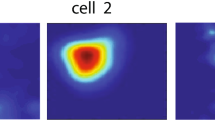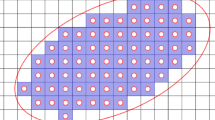Abstract
We consider the problem of monitoring the Euclidean plane using rotating sensors with detection sectors and beam sensors. We assume that intruders can appear anywhere at any time and move arbitrarily fast, and may have full knowledge of the sensor network. We require that such intruders be detected within a finite amount of time. We give an optimal network for this problem consisting of a combination of rotating sensors of angle 0 and beam sensors that uses the minimum number of both types of sensors. We show a trade-off between the density of beam sensors needed and the angle of the detection sector of the rotating sensors. Secondly, we give a family of sensor networks using only rotating sensors for the same problem, that demonstrate a trade-off between the detection time and the density of rotating sensors used. We show that the density of rotating sensors required in this case can be significantly reduced by increasing the angle of detection sectors. Finally, we show that our results on the infinite plane can be used to derive sensor networks that monitor some finite regions using a density of sensors that is asymptotically the same, or close to that of the infinite plane case.














Similar content being viewed by others
Notes
In practice, the intruder may move faster than the speed of the rotating sensor.
References
Balister, P., Bollobas, B., Sarkar, A., Kumar, S.: Reliable density estimates for coverage and connectivity in thin strips of finite length. In: Proc. of the 13th Annual ACM Int. Conference on Mobile Computing and Networking, pp. 75–86 (2007)
Bhattacharya, B., Burmester, M., Hu, Y., Kranakis, E., Shi, Q., Wiese, A.: Optimal movement of mobile sensors for barrier coverage of a planar region. Theor. Comput. Sci. 410, 5515–5528 (2009)
Chen, A., Kumar, S., Lai, T.H.: Designing localized algorithms for barrier coverage. In: Proc. of the 13th Annual ACM International Conference on Mobile Computing and Networking, pp. 63–74. ACM Press, New York (2007)
Czyzowicz, J., Kranakis, E., Krizanc, D., Lambadaris, I., Narayanan, L., Opatrny, J., Stacho, L., Urrutia, J., Yazdani, M.: On minimizing the maximum sensor movement for barrier coverage of a line segment. In: Proc. of ADHOC-NOW. LNCS, vol. 5793, pp. 194–212. Springer, Berlin (2009)
Czyzowicz, J., Kranakis, E., Krizanc, D., Lambadaris, I., Narayanan, L., Opatrny, J., Stacho, L., Urrutia, J., Yazdani, M.: On minimizing the sum of sensor movements for barrier coverage of a line segment. In: Proc. of ADHOC-NOW. LNCS, vol. 6288, pp. 29–42. Springer, Berlin (2010)
Kumar, S., Lai, T.H., Arora, A.: Barrier coverage with wireless sensors. Wirel. Netw. 13(6), 817–834 (2007)
Huang, C.F., Tseng, Y.C.: The coverage problem in a wireless sensor network. In: Proc. of the 2nd ACM International Conference on Wireless Sensor Networks and Applications, WSNA’03, pp. 115–121. ACM, New York (2003)
Li, X., Frey, H., Santoro, N., Stojmenovic, I.: Localized sensor self-deployment with coverage guarantee. ACM SIGMOBILE Mob. Comput. Commun. Rev. 12(2), 50–52 (2008)
Scheibe, K., Huang, F., Klette, R.: Pose estimation of rotating sensors in the context of accurate 3d scene modeling. J. Univers. Comput. Sci. 16(10), 1269–1290 (2010)
Lee, S., Chung, W.-K.: Rotating IR sensor system for 2.5d sensing. In: Proceedings of the 2006 IEEE/RSJ Int. Conf. on Intelligent Robots and Systems, pp. 814–819 (2006)
Kershner, R.: The number of circles covering a set. Am. J. Math. 61, 665–671 (1939)
Author information
Authors and Affiliations
Corresponding author
Additional information
This work was supported by VEGA 2/0136/12 (S. Dobrev) and NSERC Discovery Grants (L. Narayanan, J. Opatrny).
Rights and permissions
About this article
Cite this article
Dobrev, S., Narayanan, L. & Opatrny, J. Optimal Sensor Networks for Area Monitoring Using Rotating and Beam Sensors. Theory Comput Syst 54, 622–639 (2014). https://doi.org/10.1007/s00224-013-9483-y
Published:
Issue Date:
DOI: https://doi.org/10.1007/s00224-013-9483-y




